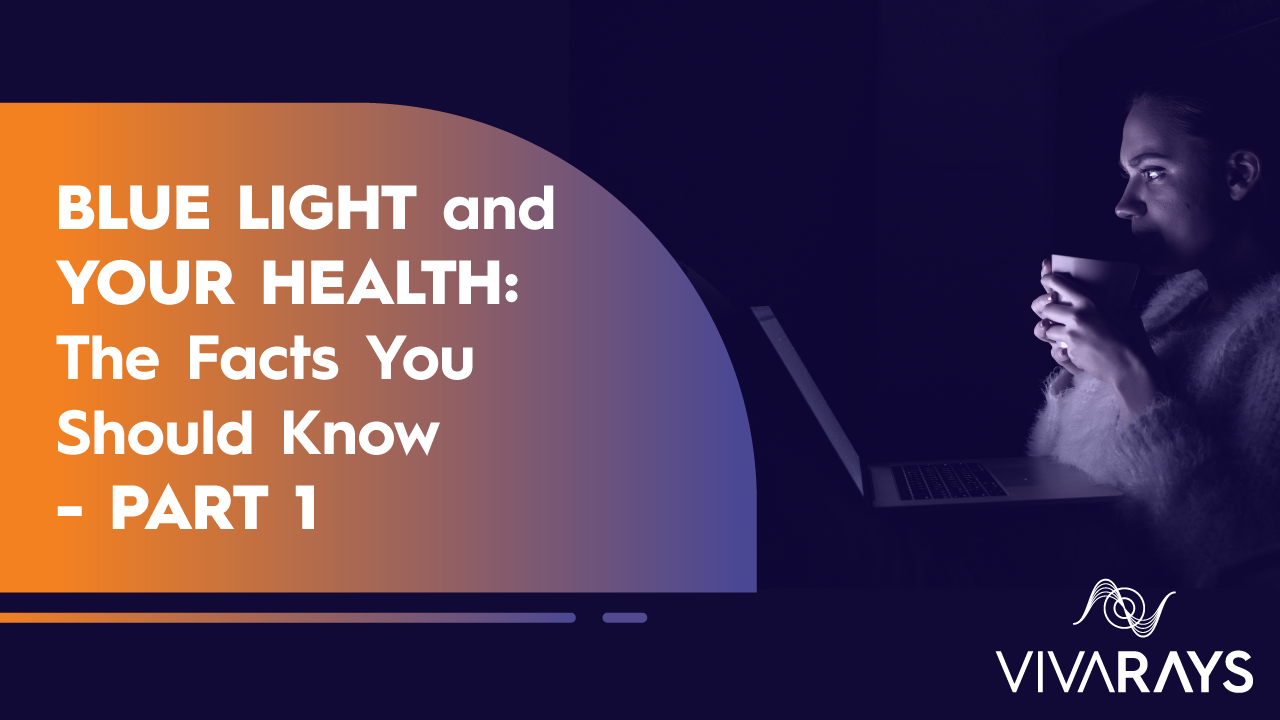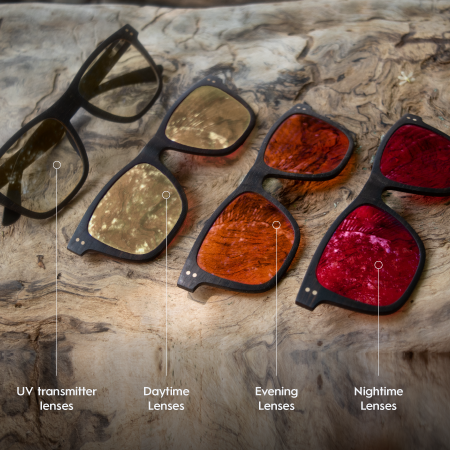Blue Light and Your Health: The Facts You Should Know - Part 1

How Light Affects Your Health: The Importance of Circadian Rhythm and CLOCK Genes
Have you ever stopped to think about how light affects your health?
It might not be something you've considered, but it turns out that every cell in your body is tied to something called CLOCK genes.
These genes act like little cellular clocks, keeping track of the time of day, and their primary environmental time cue is LIGHT.
You've got trillions of cells in your body, each with its own little clock, all working together to keep track of your circadian rhythm.
That's the rhythm that governs everything from your body temperature to your hormone regulation to your cell regeneration.
And the master timekeeper of all these clocks is a mass of nerve cells in your brain called the suprachiasmatic nucleus (SCN). It's like the conductor of a symphony, keeping everything in sync.

But here's the thing: when your cells get out of sync with each other, it can cause all kinds of health problems.
Have you ever had a bad night's sleep and woke up feeling achy and sore?
Well, it turns out that improper sleep can actually cause inflammation in your body.
That's because the little clocks inside your cells, called CLOCK genes, help regulate your body's natural rhythm, including when you sleep and when you're awake.
When those clocks get out of whack, they can throw off your whole system and cause all sorts of problems.
One of the ways this can happen is through exposure to artificial blue light, like the kind that comes from your phone or computer screen.
Blue light can disrupt your sleep cycles, making it harder to fall asleep and stay asleep.
And when your sleep is disrupted, it can cause all sorts of health problems, from increased inflammation to altered glucose metabolism.
In fact, did you know that artificial blue light — regardless of the time of day — alters glucose metabolism (blood sugar) and sleep cycles?
Think of it like a dance party. Your body's natural rhythm is like the beat of the music, and all your cells are dancing along to it.
But when you're exposed to too much artificial blue light, it's like someone turns on a strobe light and starts flashing it in your eyes.
Suddenly, your cells can't keep up with the beat anymore, and the whole dance party falls apart.
So, it's important to be mindful of how much blue light you're exposed to, especially before bed.
It's pretty amazing how much our health depends on these tiny little clocks inside our cells.
In fact, there's even a whole field of medicine called chronopharmacology that looks at how drugs interact with CLOCK genes.
For example, did you know that the survival of mice injected with E. coli depends on the time of day of the injection?
For instance, research has shown that the outcome can vary significantly depending on the circadian rhythm of the animals.
Timing really does matter when it comes to introducing agents into biological systems!
So, let's think of your circadian rhythm as a symphony.
Your cells are like the orchestra, each playing its own part. And the SCN is the conductor, making sure everything stays in time. When everything syncs up, you get a beautiful song.
But if even one part gets out of tune, you can lose the entire piece.
It's fascinating to think about how something as simple as light can have such a profound effect on our health.
So, let's dive a little deeper and explore how blue light specifically affects our bodies, and what we can do to protect ourselves from its potentially harmful effects.
Sleep and Wakefulness: The Role of Melatonin and Cortisol in Regulating Your Circadian Rhythm
Let's talk about how your body regulates sleep and wakefulness.
You know how your body temperature rises and falls throughout the day? Well, your sleep and wake cycles work in a similar way.
Melatonin, a hormone produced in your pineal gland, is responsible for making you feel drowsy at the right time. It's often called "the chemical expression of darkness" because it's produced when it gets dark outside.
But, here's the catch: melatonin relies on light and dark cues processed by your suprachiasmatic nucleus (SCN), the master timekeeper of your body's trillions of clocks.
So, when your SCN senses that it's dark outside, it signals your pineal gland to produce melatonin, and voila, you feel sleepy.
On the flip side, cortisol helps with wakefulness. It's a hormone that surges in the morning, giving you that boost of energy you need to start your day.
As the day goes on, cortisol levels slowly drop and level off.
In an ideal situation, your cortisol levels peak in the morning and lower toward the evening, while your melatonin levels peak in the evening and lower throughout the day.
This creates two bell curves that work together to regulate your sleep and wake cycles.

At the molecular level, melatonin binds to receptors in your cells, altering the expression of clock genes like PER and CRY.
This helps your body keep track of time and know when it's time to sleep or wake up.
So, next time you're struggling to fall asleep or feeling extra groggy in the morning, remember that it's all about your body's circadian rhythm and those trillions of clocks in your cells.
And, if you're interested in learning more, keep reading because we just scratched the surface!
Artificial Light and Your Circadian Rhythm: How It Disrupts Your Sleep-Wake Cycle
Let's take a quick trip back in time to the days before Thomas Edison invented the light bulb.
We used to rely on the sun for light during the day and darkness at night, which helped us live in sync with our natural sleep-wake cycles.
But now, things have changed drastically. We're surrounded by artificial light sources almost 24/7, and it's having a significant impact on our circadian rhythm.

Just take a look at the above picture from space showing the nighttime reality of Spain and Portugal. Does it look natural to you?
That's because 54 percent of the world's population lives in urban areas, which are the main sources of light pollution.
And that number is only going to grow, with estimates suggesting that 66 percent of the world's population will live in urban areas by 2050.
The truth is that 80 percent of the world's population now lives under light-polluted skies, and if you narrow it down to just the United States and Europe, that number climbs to a staggering 99 percent.
The virgin night sky is now so foreign to most of us that we have to go to very remote areas to see it as intended.

ON A PERSONAL NOTE: The farming trip in northern Quebec, which led me from depression, suffering and desperation to vitality and inspiration, also provided an opportunity to experience the beauty of the natural world in a new way.
With little to no artificial light at night, the virgin night sky became visible, a sight so foreign to most of us in our modern lives.
This experience allowed me to connect with the stars, the solar system and the universe in a way I never had before.
It awakened my spiritual connection to the universe, bringing a sense of oneness with all things beyond space and time.
As I gradually experienced partial illumination during those farming trips, I realized the transformative power of connecting with nature and the importance of preserving it for future generations.
Healthy light VS Junk light
Now let's talk about the colors of light that surround us.
If you compare the visible spectrum reference chart to common artificial light sources, you'll notice that we're getting an unbalanced surplus of violet, blue, and green light.

This is because most artificial light sources peak in the 380-495 nanometer range, which is exactly where popular devices like iPads and iPhones also feature peaks in the violet and blue range.

This unbalanced surplus of blue light is particularly concerning because it can suppress melatonin production, making it more difficult for us to fall asleep at night.
So, it's not just about the amount of light we're exposed to, but also the type of light.
Conclusion
Light plays a crucial role in regulating our body's natural rhythm, with the CLOCK genes and the suprachiasmatic nucleus acting as key players.
Disruption to our natural rhythm can lead to health problems, which is why it's essential to be mindful of our exposure to artificial blue light from devices such as phones and computers.
These devices can affect the production of important hormones such as melatonin and cortisol, leading to sleep problems and other health issues.
Therefore, it's crucial to manage our light exposure and prioritize healthy sleep habits to maintain our overall well-being.
Keep an eye out for part 2 of this article where we will delve deeper into the significant role that light plays in our lives, and provide effective strategies to manage it for deep sleep, optimal energy levels and overall wellbeing.





A lovely day Kelly! Our colored lenses such as yellow, orange and red are meant to be worn whever you are exposed to artificial lighting only. Some of the posts are for content use only for better lighting but they are surely for junk lights. Our UVT clear prescription lenses are the only ones designed for outside use during the day. Yes, do make progressive lenses and you can click on “Prescription”. We don’t have a shop at the moment but you can order them as no prescription to try them on then email <support@vivarays.com> for further assistance. Since you work night shift and had a lassie surgery, the best option is to filter all the lights the comes into your eyes. Since you work night shift, the best option for you is <https://vivarays.com/collections/clipngo-3-in-1> with prescription. You can also email us if you need more help 💛🧡❤️
I see lots of photos with people wearing the glasses outside, are they meant to be wore outside as well? I am a nurse that works night shifts… does the prescription lenses include progressives? I don’t see how to order them? Is there any places that have the frames to try on before you order prescription? I had lassie surgery for vision correction 20 years ago…. are my eyes too damaged for any of this to make a big enough difference? Thank you!
Leave a comment